Presenting new creatures:
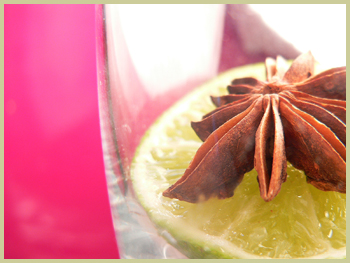
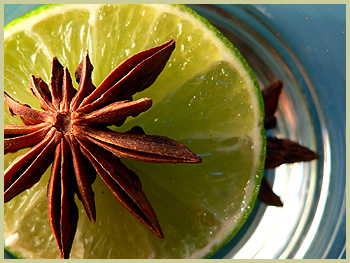
Who has not been puzzled and intrigued by the shape and the strong smell of a star anise? Such an elegant shape, playful, powerfully fragrant.
It belongs to this not-so-known group of spices that according to me, deserves a larger attention.
A few days ago, I was making my regular batch of yogurt, and following Philip’s wise suggestion, I decided to use star anise in the yogurt preparation. During the process making, that is when the milk was brought to a boiling point, I added 2 pieces of star anise to flavour the milk. The result was very nice. I was unsure about the amount to add, and have to say that I could have gone with more than 2 for 4 cups of milk.
But here is a bit of background about this fascinating spice:
The Spice
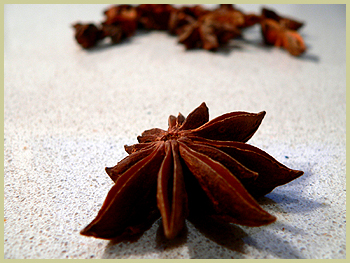
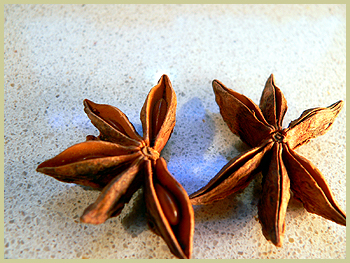
Star anise (Chinese star anise) is a spice which consists of the dried fruit of the Illicium verum, coming from a slender evergreen tree of the family Illicaceae related to Magnoliacea. As suggested by its name, it takes the shape of a star with between five and ten pointed boat-shaped sections (eight on average). These hard sections are called seed pods– they all contain a brown seed-, with a tough skinned and rust coloured (or dark reddish brown) and measure about to 1/4�? long. The star shaped fruits are harvested just before ripening and dried. They are available whole, or ground. Their cultivation is almost entirely confined to S. China and parts of SE Asia.
Flavour
Powerful, more pungent and stronger than anise, evocative of a bitter aniseed, of which flavour star anise is a harsher version.
Culinary use
Whole stars can be used as such or they can be grounded as well. A note to keep in mind, because of its powerful flavour, only small amounts are used.
This spice is widely used in Chinese cuisine, and to a lesser degree in South Asia and Indonesia. Star anise is an ingredient of the traditional five-spice powder of Chinese cooking. It is also one of the ingredients used to make the broth for the Vietnamese noodle soup called phở.
It is used a lot in sweetmeats and confectionery, but also in meat dishes such as pork, duck and poultry. For example, in Chinese red cooking, where the ingredients are simmered for a long time in dark soy sauces, star anise is almost always added to beef and chicken dishes. Chinese stocks and soups very often contain the spice.
Medical facts
Star anise has carminative, stomachic, stimulant and diuretic properties ; it is used in a tea as a remedy for colic and rheumatism, and the seeds are sometimes chewed after meals to aid digestion.
It is also a common flavouring for medicinal teas, cough mixtures and pastilles.
It is worth noticing that Japanese star anise (Illicium anisatum), a similar tree, is not edible because it is highly toxic. In Japan, people use it as incense to be burned.
So here we are. I think this spice deserves a bigger room in my kitchen.
Keiko from Nordljus uses it in a delicious summer vegetable dish, to prepare a vegetable nage.
As one of my 2006 cooking resolutions, I decided that I would use star anise more, starting in crème brûlée, because, yes I can make this confession, I love crème brûlée, and my hubbie is a master at making it! I just need to convince him…

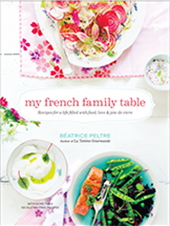
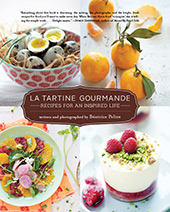
quelles photos splendides!
Interesting post and as usual, wonderful pics.
I have never used star anise myself but I am now tempted to buy some and experiment.
Keep up the great blogging!
(P.S.) I’d love if you shared your yogurt recipe on your blog one day …
Hi Bea, Star anise is such a wonderful spice to use and it seems either people love it or they hate it – I usually use it for my Indian recipes/currys and have caught myself adding too much, which in combination with slightly roasting the spices, can really impact the dish.
Happy -belated- New Year you, too!
look at you go girl!
great looking photographs. (Have you been practising : ) ???
magnifiques photos! j’en suis bouche bée!
Alas, I can’t abide star anise. It’s an almost visceral reaction. I’m led to wonder why this is true of specific flavors for specific people. A friend cannot come near fresh coriander, another reacts in the same way to citron. Doesn’t mean we cannot eat them without allergic reactions, it’s more of a creepy …distaste. Any medical feedback on these problems?
Thanks for your nice comments all.
Yes yes, I like food shooting and there is a ton of improvement for me to achieve so the only way is to practice! 😉
Kudzu, do you get this allergy just by smelling the spice or eating it? Was is the Chinese kind? I know my brother got sick once because the biscuits he ate had too much star anise.
Ivonne, check this entry for the how about home made yogurt and let me know if you are successful.
http://www.latartinegourmande.com/2005/12/06/homemade-yogurts-as-the-most-exquisite-dessert/
Bea
happy belated new year, Bea – your pictures are absolutely gorgeous!
Hi Keiko,
Thanks for the compliment, I am practicing a lot, hence cooking a lot too ahahah ! ;-). A lot of room for improvement still. Nothing compared to your amazing shots I have to say!
Hi Oliver,
I forgot to mention, do you have a good Indian recipe to share with star anise? 😉 I am curious!
Merci
Bea
I have a child who is very allergic and has sesame seed allergy. Is star anise known to cause food allergy. Is it the fruit or the seed which is used in cooking. Please help – one of his favourite foods now has star anise in. Many thanks.
I quite enjoyed a mild sweetened star aniseed drink during my last visit to Marrakech & I have brought a packet home. For best results, I was told to use 2 stars for 1/2 litre of boiled water & to let it brew for 4/5 minutes.
Believe it or not – I am allergic to Star Anise, and I’m Chinese >.<
My first food allergy was Peking Duck (made w/ Star Anise) made me broke out w/ Hives when I was maybe 10 years old. Since then, I’d stay away from all food w/ Star Anise (lots of meat stews, Chinese food dishes) — and have been for over 30 years. I don’t have Peanut / Sesame / Soy / Wheat allergy, but I seem to have recently developed sensitivity to Roasted Cashews.
So to answer your question, there is positive proof that one can be allergic to Star Anise.
Just found you site – very interested in Scott’s comment from December 2007 (now Sept 2010) becaue I have just had my first experience of hives (in 45 years) and I think the cause if too much Chinese five-spice in a fruit compote that I made last night.
I love five-spice and have regularly added it to mashed banana before spreading it on bread and toasting it (strange but true) – so when making the compote I added a generous heaped teaspoon.
I ate some compote last night (on a slice of cold yorkshire pudding – yes I know, sounds mad but totally delicious with cream) at about 7pm and by 9pm had broken out in weals under my arms.
Puzzled but guessing it was an allergic reaction, I took some antihistamine – which did the job.
Then today, in the interests of science I had some more of the compote for lunch – by 3pm the raised rash was back and had spread to other areas.
Seems I am going to have to choose a different spice in future.